May 20, 2025 | 09:53 GMT +7
May 20, 2025 | 09:53 GMT +7
Hotline: 0913.378.918
May 20, 2025 | 09:53 GMT +7
Hotline: 0913.378.918
Leading us to his orange garden, Mr. Truong Quoc Viet from Kim Hoa Commune, Tuyen Hoa District, Quang Binh Province showed around his area of 10-ha of orange, saying: "This is the first orange crop of which the fruits must be technically removed but I find the trees are still so healthy that I only cut down half of the number of fruit. A trader once committed to pay VND600 million for the whole garden.”
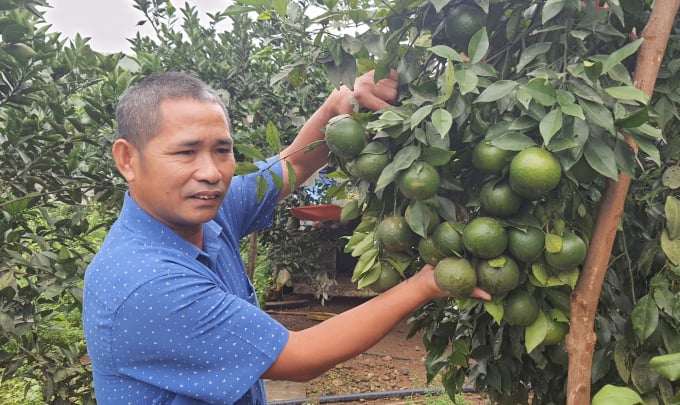
Viet said that his family now has over 4,500 orange trees promising to give high-quality fruits. Photo: Tam Phung.
The land of Kim Lu in Kim Hoa Commune seems to be always associated with the name of “forest workers". Young men and women here used to follow each other to work as "illegal forest loggers". The illegal occupation became a bad “livelihood tradition” of this poor but rich- in-resources countryside.
Like them, Truong Quoc Viet also followed his friends to the forest for logging woods. Precious timber bars were torn into long boxes, pulled out from the forest to hide near Kim Ly train station. When the train stopped there, they loaded the woods onto the train to go the north. In some months of heavy rain, it was impossible to enter the forest so Viet took the train to Dong Hoi - Vinh "escorting" merchants for some pocket money.
After three years of joining and then retiring from the army, Viet and his friends went to Laos to earn a living with a dream of getting rich. However, he later found that he had not saved anything for his life. His youth also passed so fast.

The first batch of oranges was branded as "Kim Lu Orange". Photo: Tam Phung.
Wealth was nowhere to be seen, only health was more and more worn out. Viet thought a lot but couldn't find a new way.
A few years ago, he discovered a hilly area about 1km from Ho Chi Minh Road had a lower level than the surrounding mountains. Viet liked it very much. He spent most of his time and labor on reclaiming it to grow acacia and rubber… But then he again found it hard to earn a living or get rich from it.
Once returning from Laos, he was lying down smoking a cigarette when a friend invited him to travel to Ha Tinh and some other central regions where he found many families and localities growing a type of orange that is very sweet and fragrant. Particularly it has brought them with high income. Thus, wherever he went, he tried to learn and explore it.
Another time, he visited a friend and talked with his mother who advised him to find a garden to plant oranges. The words of his friend's mother had enlightened him.

Right in the first harvest crop, Viet can earn VND600 million from his orange garden. Photo: Tam Phung.
At the beginning of 2018, Viet officially brought a new orange variety to plant on his hilly farm. The variety he chose is citrus with origination from Huong Khe, Ha Tinh Province. Viet destroyed rubber and all other trees to grow oranges. Not many people first believe in his decision except Mr. Tran Thanh Hai, Director of Quang Binh Province’s Agriculture and Fisheries Promotion Center (AFPC). Hai was the only one who wholeheartedly encouraged and supported him both mentally and physically in creating such an orange garden.
In the low hilly land, Viet planted 1,000 more Phuc Trach pomelos and lemons. Being supported by the Center, he was very confident. Viet bought fresh buffalo and cow manure and fermented them for 4 months before using them to fertilize the garden. "With this organic fertilizer which is composted according to new techniques, bacterias that cause diseases have been limited," said Viet.

With the companionship of agricultural promotion officials, Viet’s orange garden has been developed in an organic and sustainable direction. Photo: Tam Phung.
After 3 years, the orangesand pomelos have grown up well. This year is the first harvest of the orange crop in which some trees bear several hundred fruits.
Theoretically, fruits of the first crop must be cut off to nourish the tree for the next crop. But Viet decided to cut only half of them on each tree. He explained: "The trees grow healthy and develop well due to good techniques and an abundant organic fertilizer, so it can still retain its strength. That's why I can harvest right from the first crop."
On the eve of the harvest, a trader had committed to buying the whole garden at a price of VND600 million, but Viet did not sell. He said when the oranges were harvested, he would hire labor to cut the fruits every day, pack them and sell them under the brand name of "Kim Lu Orange". The orange tasted sweet with a mild aroma so it had satisfied even the fastidious people.
After only some harvests, the name "Kim Lu Orange" has been known to everyone. Viet now is quite busy with orders and visitors. He has to ask dozens of local laborers and relatives to help harvest, process, pack, and transport the oranges.
At the end of the orange and pomelo crop, the money he got was much more than that of the trader’s order. Viet said cheerfully that he also spent a significant amount of the harvested fruits as gifts to relatives, friends, and close partners. Everyone who has the oranges also compliments them as sweet and fragrant. They also feel secure with such products using organic fertilizers.
Up to now, on an area of nearly 15 hectares of hilly land, Viet has structured it into an orange area with about 4,500 trees, a garden with 2,000 pomelos, and 1,000 roots. All are promising for an even greater harvest in the next crop. "The output of the next crop promises an estimate of about 70 tons of oranges and 10 thousand of pomelos... At that time, billions of dong is no longer a dream, but very near to be true," Viet firmly said.
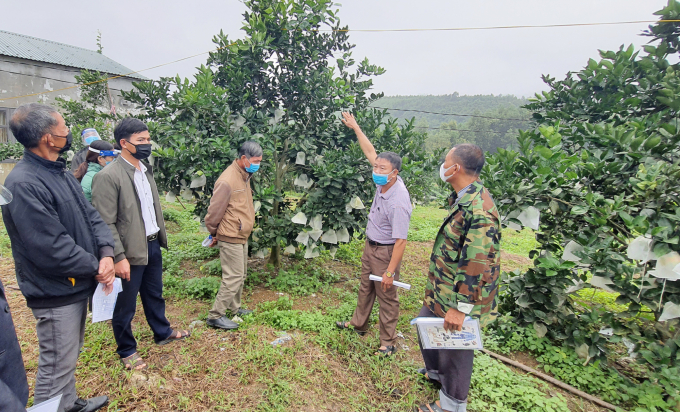
Quang Binh Agriculture and Fisheries Promotion Center chose Viet‘s orange garden as a place to transfer technology to orange growers in western Quang Binh Province. Photo: Tam Phung.
When we visited Mr. Viet's orange farm, it was also the time for Quang Binh AFPC to open a conference to transfer orange growing techniques to locals of Tuyen Hoa and Minh Hoa districts.
Mr. Dinh Van Ba (Tuyen Hoa District) said he was excited at Viet's orange garden saying that: “I have registered with the Center I will renovate my gardens to convert to this model.”
Mr. Tran Van Hai, Director of Quang Binh AFPC said in recent years, the Center has implemented many models of citrus trees such as oranges and pomelos in districts of Le Thuy, Quang Ninh and Bo Trach, Tuyen Hoa and Minh Hoa. Up to now, the deployment area has reached over 50 ha.
“Basically, all models have started to harvest and give growers a profit of VND120-200 million/ha...,” added Hai.
According to Hai, Quang Binh has the strength of the western hilly region to expand the area for growing oranges and pomelos. However, it is also necessary to develop according to the roadmap and put high technology into production to meet market demand and easily output for farmers.
Translated by Linh Nguyen
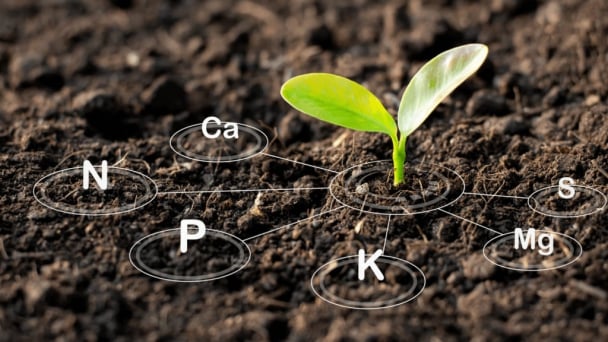
(VAN) Vietnam aims to become a 'leader' in the region in the capacity and managing effectively soil health and crop nutrition.
![Reducing emissions from rice fields: [Part 1] Farming clean rice together](https://t.ex-cdn.com/nongnghiepmoitruong.vn/608w/files/news/2025/05/05/z6509661417740_a647202949c539012a959e841c03e1d3-nongnghiep-143611.jpg)
(VAN) Growing clean rice helps reduce environmental pollution while increasing income, allowing farmers to feel secure in production and remain committed to their fields for the long term.
/2025/05/19/5136-1-144800_230.jpg)
(VAN) The Nghe An Provincial People's Committee has just approved the list of beneficiaries eligible for revenue from the Emission Reductions Payment Agreement (ERPA) in the North Central region for the year 2025.
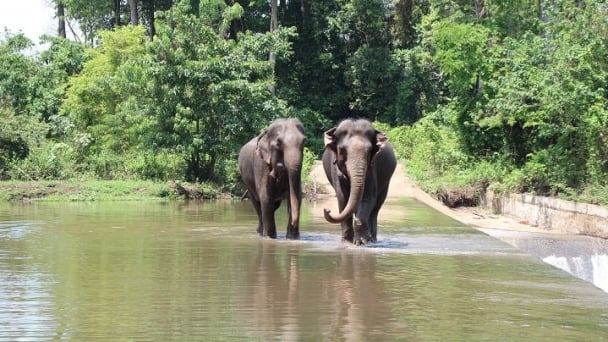
(VAN) 14 out of 35 domesticated elephants in Dak Lak province have had their living conditions improved, with 11 of them currently participating in the non-riding elephant tourism model.

(VAN) Muong Nhe Nature Reserve hopes that being upgraded to a national park will lay the foundation for forest protection efforts to be carried out in a systematic, modern, and sustainable manner.
/2025/05/16/3923-2-171845_52.jpg)
(VAN) Lower costs, higher yields, and improved soil quality are outstanding benefits that soybeans bring when integrated into the crop rotation system.
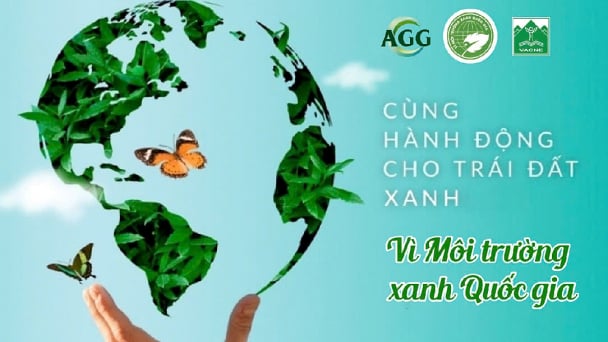
(VAN) The 'For a Green National Environment' programme aims to promote a green lifestyle, support businesses in implementing ESG practices, and turn Net Zero commitments into concrete actions.